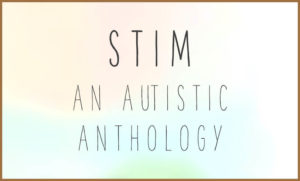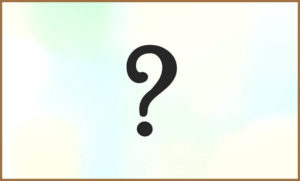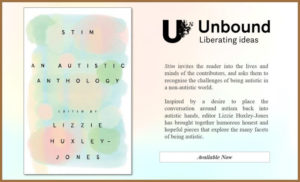Stim is the autistic spectrum, just not as we know it. Stim sets your expectations only to alter them and, although Stim does not try to influence your thoughts on all things autism, its introspective look at life on the spectrum will change the picture you have come to associate it with.
Stim is confusing, Stim is complex and that’s exactly how Stim should be. So, while this does mean that Stim certainly wasn’t the book I expected when I picked it up, it has since meant that its unforgettable essays, artworks and stories have made its somewhat unorganized journey the perfect title for shaking up the autistic narrative. But, what actually is Stim?

What is Stim?
Kickstarted by almost 800 supporters (including myself – so make of that what you will), Stim is an autistic anthology which, although doesn’t always place autism front and centre, undoubtedly has our community at its heart (yes, I know how clichéd that sounds).
Featuring deep cut discussions of autism, visceral artworks, short engaging stories and a comic strip thrown in there for good measure, the Unbound published book is the creation of Lizzie Huxley-Jones and was given life in the hope that readers will question their expectations and preconceptions of autism.
Due to the nature of the anthology, it would be impossible to break down every work which is cradled on each page of Stim. So, in the interest of time, I will cut to the chase by confirming that Stim unquestionably delivers on everything it sets out to do.
This is in no small part thanks to the range of talent on offer here and, while this can be seen in headline names like Odd Girl Out‘s Laura James or The State of Grace’s Rachael Lucas, it’s the discovery of new perspectives amongst the old which really sold the experience.
Furthermore, although I am particularly hesitant to call out which entries within Stim were my favourite (as every piece of the anthology is so diverse and incomparable that, what might appeal to me, might not to you), I do believe there is something to be said about the back to back sections of Hungry and Stripping While Autistic – both of which are worlds apart and both of which I haven’t been able to stop thinking about since I read them.
At this point, I should also say that Stim contains many themes which could be considered upsetting. Yet, this isn’t so much a warning, but a selling point which draws attention to how the anthology ventures to places other titles are yet to set foot e.g culturally, religiously, sexually and any other way which would make its film poster feature a hefty 15+ rating.

What is Stim…Really?
I was expecting to find myself within the pages of Stim as, despite the knowledge that this book was designed to alter expectations of autism, I was so sure that the remodelled archetype would wear some resemblance to me. After all, I am autistic and surely that means, in some way, autism looks like me.
Instead, when I began reading Stim, I found people (18 people in fact), authors, artists and academics who, while also spectrum associated, had lived entirely separate lives to mine and whose life engagements had shaped their personalities, values and ambitions in ways which differ to my own. The book subsequently reminded me of its back-cover question ‘Who do you picture when you think of an autistic person?’ and I knew that, in many ways, I had thought wrong.
Stim is like that though, one minute you could be looking at a disrupted word aggregation, scrutinizing the listening process of an individual with communication deficits, the next you are reading a story of a pride of lions in the Kalingehti, fantasised by a West Country aspie whose actions have resulted in a distinct interest in felines. I suppose this is where I should say that Stim has something for everyone, but that’s not quite true. Instead, Stim has everything… but only for those who are looking for it.
In this regard, the book’s chapters are unforgiving in the best possible way, as explanations and other hand-holding are brushed aside for a path that favours those who don’t want questions answered but prefer to get lost in the endless exploration between asking and uncovering.

A Post-Stim World:
In summary, Stim really feels like the start of a new narrative and, if placed in enough hands, Stim could be the end of an old dialogue too.
Stim achieves this through gritty and real experiences expressed through unique voices and, while I am certain that this will leave some readers a little uncertain (like me), I believe Stim’s contagious ambiguity is apt for how we should feel after hearing only 18 voices out of an estimated 74,000,000 strong community.
Of course, while I now feel more lost than ever in my post-Stim world, I love how fresh the spectrum has come to feel as a result – it’s given me a chance to revisit old concepts with a new pair of eyes and for that, more than anything, I am perhaps most thankful for the opportunity Stim presents.
[Stim: An Autistic Anthology is out now and can be purchased by clicking here]
Carry on the Conversation:
What is the last book you read that has really stuck with you? Let me know in the comments below. And, to see more of my most anticipated autism books for 2020, check out my article on The Best Autism Books to Look Forward to in 2020.
As always, I can also be found on Twitter @AutismRevised and via my email: AutisticandUnapologetic@gmail.com.
If you like what you have seen on the site today, then show your support by liking the Autistic & Unapologetic Facebook page. Also, don’t forget to sign up to the Autistic & Unapologetic newsletter (found on the sidebar on laptops and underneath if you are reading this via mobile) where I share weekly updates as well as a fascinating fact I have found throughout the week.
Thank you for reading and I will see you next week for more thoughts from across the spectrum.



